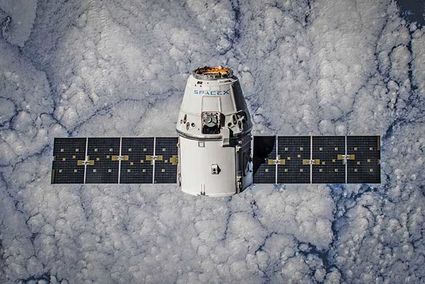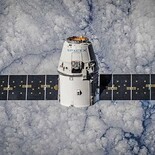Five Years After the Shuttle
Sky Watch

Sierra Nevada Corporation
The lifting-body concept is too attractive to go quietly into the night. Dream Chaser blows the dust off of some outstanding early concepts.
President Obama is a lame duck. That means that his primary focus is no longer on bold plans for the future, but on what his administration has accomplished over the last eight years – his legacy. My personal feeling is that history will judge him to have been a decent president; not stellar, but not bad. He came into office with a global economy in chaos and an America entangled in a nightmarishly complex international situation. Yet, we're now doing fairly well when viewed from a global perspective. We certainly could have done worse.
In the long run (which is what legacies are all about), the one thing Mr. Obama may be most remembered for could concern an issue that he is often accused of being rather indifferent toward: America's space program. The Bush Administration had put NASA firmly on a path back to the moon, with NASA maintaining their monopoly on American access to human spaceflight. President Obama put the brakes on all that and proposed a whole new idea: Let's turn the job of getting people and things into low earth orbit (LEO) over to private industry, and let NASA focus on deep space exploration. That meant grounding the Space Shuttle and using those operating funds to help private companies develop a new generation of American spaceships and rockets. NASA could then pay those companies to send Americans to the International Space Station (ISS), for a start. Meanwhile, NASA could continue work on deep exploration, essentially picking up where Apollo left off.
The Space Shuttle landed for the last time five years ago this July. This seems like a good point at which to access President Obama's bold gamble.
No American spaceships have taken astronauts into orbit since the end of the Shuttle Program. We've been able to rely on the Russians to take our astronauts to and from the ISS without incident (despite several serious diplomatic issues on the ground) – for the right price. While American companies have successfully sent cargo to the ISS, none of the craft have been human-rated. It looks like President Obama will leave office without realizing his dream of commercial American spaceships.
No American spaceships have taken astronauts into orbit since the end of the Shuttle Program. We've been able to rely on the Russians to take our astronauts to and from the ISS without incident (despite several serious diplomatic issues on the ground) – for the right price. While American companies have successfully sent cargo to the ISS, none of the craft have been human-rated. It looks like President Obama will leave office without realizing his dream of commercial American spaceships.
NASA funded the development of several concepts to deliver supplies to the ISS with an eye toward creating a human-rated spacecraft. Out of that effort, three notable ventures are still underway.
SpaceX has privately developed a new rocket that can send a capsule to LEO for a fraction of the cost of traditional suppliers. The Falcon 9 rocket has delivered seven Dragon capsules full of supplies to the ISS. Notably, SpaceX has managed to safely land the first stage rocket booster twice so as to recover and reuse its engines and other expensive hardware. This is an important first for rocketry. Their goal is to recover and reuse the entire rocket, dramatically lowering the cost of reaching space.
Boeing was also selected to build a space capsule to take astronauts to the ISS. The CST-100 Starliner takes the best of the Apollo Command & Service Module concept and updates it with modern electronics and materials. It has room for seven astronauts and can sustain them for up to 60 days. It is designed to be launched atop the venerable Atlas V or Delta IV, or even SpaceX's Falcon 9. Development, manufacturing, and testing continue at the old Space Shuttle Orbiter Processing Facility at Cape Canaveral.
Another contender is Sierra Nevada Corporation's Dream Chaser. It is an aerospace-plane not unlike the Space Shuttle. The passenger version is capable of carrying up to seven astronauts. Dream Chaser's roots go back to 1957, with several military and civilian versions considered by both the United States and the Soviet Union. Indeed, that research lead directly to the Space Shuttle.
Congress only allocated enough funds to develop two of the three spacecraft.
NASA believed that the capsule concepts had the best chance of meeting their development schedules; the lifting-body concept still has too many unknowns. Thus, Dream Chaser was reluctantly cut from the team in 2014. However, Sierra Nevada succeeded in securing NASA funds this January for a cargo version to deliver supplies to the ISS. If successful, a passenger version would still be in the offing.
Let's not forget that NASA and Lockheed Martin successfully tested the Orion deep space capsule in December of 2014. Although unmanned, the capsule contained all of the critical systems for a manned flight, all of which performed admirably. Meanwhile work on its Saturn-class Space Launch System rocket continues.
So, the American spaceflight industry hasn't just been sitting on its hands. Indeed, these are only some of the highlights of the action.
To get a better vision of Mr. Obama's probable space legacy, it will be much more helpful to try and see where we're likely to be in another five years. Barring any major catastrophes, by the middle of 2021:
–SpaceX and Boeing will be routinely leasing reusable spacecraft to NASA for sending its astronauts to and from the ISS. These spacecraft will also be available to other users for other purposes, such as university studies, commercial research or manufacturing, commercial space station construction, or space tourism. We will no longer be paying the Russians to get us into orbit. Indeed, perhaps they'll find it cheaper to catch a ride with us!
–SpaceX will have landed one of its Dragon spacecraft – Red Dragon – on Mars, becoming the first private company to send a spacecraft to another planet. This is an astounding ambition! SpaceX founder Elon Musk is dead serious, and I think he's going to make this look easy. They're currently shooting for the 2018 Mars launch window, but I told my bookie to put my money on the 2020 window.
–There's a good chance that an expandable habitat from Bigelow Aerospace will have been added to the ISS, expanding its usable volume by 35%. Space would be leased like in an office building. The additional module may also lengthen the life of the ISS.
–Orion will have made an unmanned flight around the moon, and should be ready for a manned shakedown cruise to lunar orbit with a crew of four.
–Closer to home, suborbital flights for "amateur astronauts" (as Robert Bigelow prefers to call "space tourists") will surely be underway.
Considering the far more modest aspirations of other spacefaring nations, I'd say we have a pretty robust space program. Further, we're really on our way toward turning over low earth orbit spaceflight to private companies. For a president who's perceived as indifferent to space, Mr. Obama may well be remembered for revolutionizing it.
Almanac

NASA
The SpaceX Dragon already has an impressive unmanned record in space; but its future is only beginning. Next year it's supposed to start taking astronauts to the ISS. Elon Musk tells us that, "Dragon 2 is designed to be able to land anywhere in the Solar System. (Landing on Mars) is the first flight test."
Planet watchers have an opportunity to see all of them this month. We all happen to be on the same side of the sun -- even Pluto.
Jupiter is still bright in the west at dusk, followed by (to the left) Mars in the south and Saturn on the other side of Scorpius' head. All are still fine targets for backyard telescopes.
Uranus and Neptune (in Pisces and Aquarius, respectively) are best viewed in the early morning; as is Pluto, which can be found near the "Teaspoon" of Sagittarius. A large telescope is nice for Uranus and Neptune, but a must for Pluto.
Meteor season begins with the Delta Aquariids, which peak on the morning of July 28. It is one of several weak, but long lasting showers that precede the famous Perseid shower of mid-August. As always, the best time for meteor-watching is after midnight when the earth is heading "into the wind" of the storm.
We have a new moon on July 4, giving us a prime opportunity for stargazing after the fireworks.
Sunrise/Sunset: 5:43 a.m./8:12 p.m. (July 1st)







